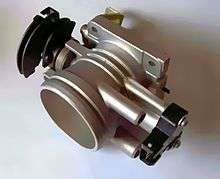Throttle position sensor

A throttle position sensor (TPS) is a sensor used to monitor the throttle position of a vehicle. The sensor is usually located on the butterfly spindle/shaft so that it can directly monitor the position of the throttle. More advanced forms of the sensor are also used, for example an extra closed throttle position sensor (CTPS) may be employed to indicate that the throttle is completely closed. Some engine control units (ECUs) also control the throttle position electronic throttle control (ETC) or "drive by wire" systems and if that is done the position sensor is used in a feedback loop to enable that control.[1]
Related to the TPS are accelerator pedal sensors, which often include a wide open throttle (WOT) sensor. The accelerator pedal sensors are used in electronic throttle control (ETC) or "drive by wire" systems, and the most common use of a wide open throttle sensor is for the kick-down function on automatic transmissions.
Modern day sensors are non contact type. These modern non contact TPS include Hall effect sensors, Inductive sensors, magnetoresistive and others. In the potentiometric type sensors, a multi-finger metal brush/rake is in contact with a resistive strip,[2] while the butterfly valve is turned from the lower mechanical stop (minimum air position) to WOT, there is a change in the resistance and this change in resistance is given as the input to the ECU.
Non contact type TPS work on the principle of Hall effect or Inductive sensors, or magnetoresistive technologies, wherein generally the magnet or inductive loop is the dynamic part which is mounted on the butterfly valve throttle spindle/shaft gear and the sensor & signal processing circuit board is mounted within the ETC gear box cover and is stationary. When the magnet/inductive loop mounted on the spindle which is rotated from the lower mechanical stop to WOT, there is a change in the magnetic field for the sensor. The change in the magnetic field is sensed by the sensor and the voltage generated is given as the input to the ECU. Normally a two pole rare earth magnet is used for the TPS due to their high Curie temperatures required in the under-hood vehicle environment. The magnet may be of diametrical type, ring type, rectangular or segment type. The magnet is defined to have a certain magnetic field that does not vary significantly with time or temperature. In case of failure of the TPS operation the CHECK ENGINE light remains illuminated even if there is no problem or error in the ECU. It cannot be corrected by clearing ECU errors by running diagnostic software. In order to rectify the malfunction the TPS needs to be replaced by a new one.
See also
Notes
- ↑ McKay, D., Nichols, G., and Schreurs, B., "Delphi Electronic Throttle Control Systems for Model Year 2000;Driver Features, System Security, and OEM Benefits. ETC for the Mass Market," SAE Technical Paper 2000-01-0556, 2000 http://www.carprogrammer.com/Z28/PCM/FAQ/Delphi_Drive_by_wire_2000-01-0556.pdf
- ↑ Garrick, R.D., Sensitivity of Contact Electronic Throttle Control Sensor to Control System Variation, Society of Automotive Engineers (SAE) Technical Paper, 2006-01-0763, April 2006. http://delphi.com/pdf/techpapers/2006-01-0763.pdf